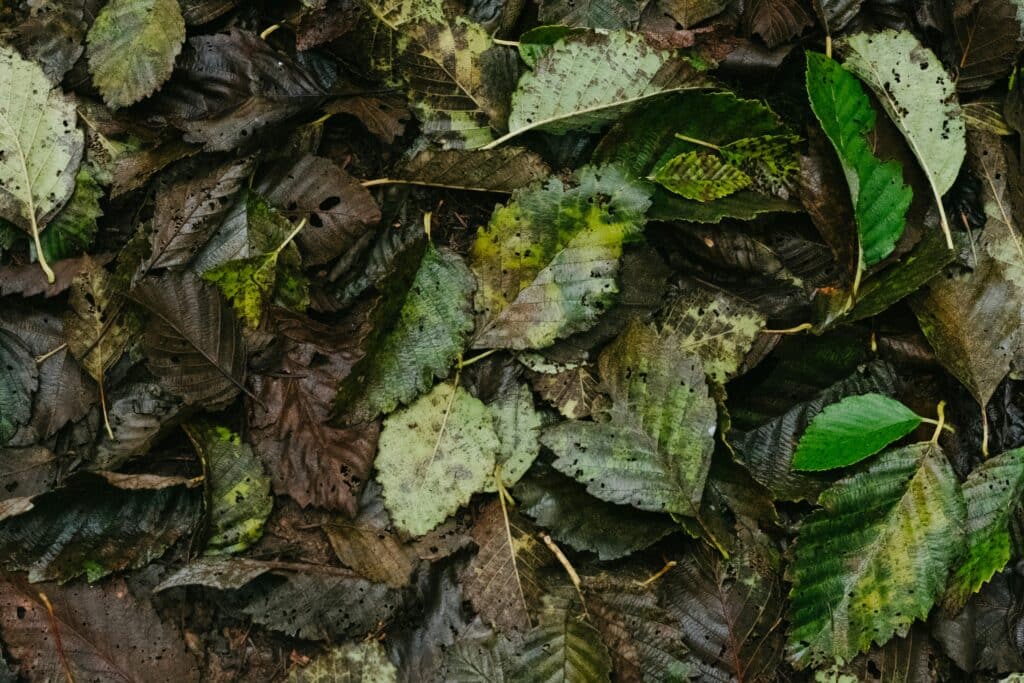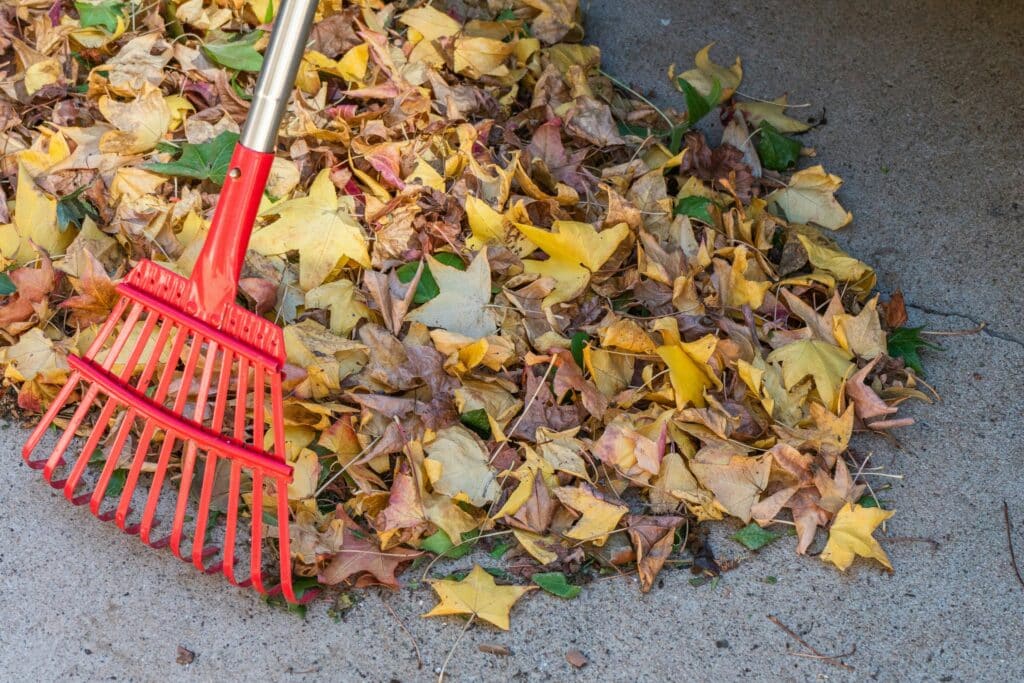This write-up will unravel the unexplored potential of leaf litter, often discarded as waste, as a quintessential tool for mulching and moisture control in your backyard.

The green thumb community is always on the lookout for organic and sustainable methods that align with the earth’s rhythm. Leaf litter, abundant and renewable, fits perfectly into this mold. As a natural mulch, it not only improves soil fertility but also enhances its water-holding capacity.
Beyond its obvious benefits, leaf litter also serves as an abode for beneficial insects and microorganisms, fostering a healthy soil ecosystem. We will delve deep into the science behind this and explore how you can harness the power of leaf litter to transform your garden into a thriving, sustainable space.
Stay tuned as we demystify the leaf litter phenomenon. You will discover practical tips and tricks on collecting, storing, and effectively using leaf litter. No more will these fallen leaves be considered ‘yard waste’. Instead, they will become your secret weapon in your journey towards sustainable gardening. Get ready to unlock the power of leaf litter!
The Chemistry Behind Leaf Litter
To truly appreciate the potential of leaf litter as a natural mulch and moisture tool, we must first delve into its underlying chemistry. Leaf litter consists of fallen leaves and other plant material that have begun the decomposition process. This material is replete with essential nutrients such as nitrogen, phosphorus, potassium, calcium, magnesium, and trace minerals.
As leaf litter breaks down, complex organic compounds such as lignin and cellulose are decomposed by fungi and bacteria, slowly transforming into humus—a rich, stable form of organic matter. This not only nourishes the soil with a broad spectrum of nutrients but also enhances its structure, aeration, and water-holding capacity. The gradual breakdown process ensures that plants receive a continuous, balanced supply of nourishment throughout the growing season, closely mimicking the self-sustaining fertility found in undisturbed forest ecosystems.
Leaf litter thus serves as a chemical engine of the soil, powering plant health naturally and sustainably.
Beneficial Organisms in Leaf Litter
One of the most overlooked yet vital aspects of leaf litter is its role as a habitat for beneficial soil organisms. Beneath a blanket of fallen leaves, a hidden ecosystem thrives—composed of earthworms, beetles, millipedes, springtails, fungi, bacteria, and a wide range of microarthropods. These decomposers and detritivores work synergistically to break down organic matter, transforming it into nutrient-rich humus.
Earthworms, for example, consume decomposing leaves and excrete nutrient-dense castings, enriching the soil with nitrogen, phosphorus, and potassium. At the same time, their burrowing activity improves aeration and soil structure, creating channels that enhance root penetration and water infiltration. Millipedes and isopods shred large leaf fragments, speeding up the decomposition process and making nutrients more accessible to microbes.
Fungi and bacteria—the microbial backbone of decomposition—further mineralize organic material, releasing nutrients into plant-available forms. These microscopic allies also form symbiotic relationships with plant roots, increasing nutrient uptake and improving plant health.
Together, these organisms drive soil fertility and biodiversity, turning a pile of dead leaves into the very foundation of life for a thriving garden.
The Power of Leaf Litter as Mulch
When applied as mulch, leaf litter becomes a natural barrier between the soil and the external environment, offering protection and functionality that rival or even surpass commercial mulches. In the heat of summer, leaf mulch shields the soil from direct sunlight, significantly reducing surface temperature and evaporation rates. This cooling effect helps maintain consistent soil moisture, critical for plant health and resilience during dry periods.
In cold climates, leaf litter acts as a thermal blanket, insulating plant roots from frost and rapid temperature fluctuations. This is especially important for perennial plants, shrubs, and bulbs, which can suffer damage from freeze-thaw cycles. By buffering the soil’s microclimate, leaf mulch creates more stable conditions for growth year-round.
Moreover, unlike synthetic mulches or bark chips, leaf litter is entirely biodegradable, meaning it continuously feeds the soil as it decomposes. This dual function—protective mulch and slow-release fertilizer—makes it a highly sustainable gardening tool.
Leaf Litter and Soil Moisture
Among the most valuable functions of leaf litter is its ability to conserve soil moisture. Once spread over garden beds or around trees, it forms a natural shield that reduces water loss due to evaporation. Especially in arid regions or during drought conditions, this moisture retention can mean the difference between thriving plants and parched soil.
By preventing direct sun and wind from reaching the soil surface, leaf litter helps the underlying soil remain cool and damp, reducing the frequency of watering needed. This is particularly beneficial in regions with water use restrictions, making leaf litter an essential component of climate-resilient gardening.
Additionally, the presence of organic material on the surface encourages microbial activity and enhances soil porosity, both of which further aid in water retention and slow-release moisture delivery to plant roots.
In essence, leaf litter is far more than garden debris—it is a living, working layer of ecosystem support, quietly contributing to soil health, biodiversity, moisture retention, and plant vitality. By embracing its full potential, gardeners can cultivate landscapes that are not only beautiful and productive but also deeply in tune with nature’s regenerative cycles.
Creating and Using Leaf Litter Mulch
Creating leaf litter mulch is a straightforward process that requires minimal effort. Collect fallen leaves and other plant material and allow them to decompose naturally. This can be expedited by shredding the leaves, which increases their surface area and hastens decomposition.
Using Leaf Litter Mulch in Your Garden
To use leaf litter as mulch, simply spread it around your plants, ensuring it does not touch the plant stems to prevent potential fungal issues. The mulch should be about two to four inches thick. This is sufficient to deter weed growth, conserve soil moisture, and provide a steady supply of nutrients to the soil.
Leaf Litter: A Sustainable Choice
Leaf litter is more than just seasonal debris—it’s a powerful and sustainable gardening resource. By reusing fallen leaves, gardeners can reduce waste and promote a circular economy, turning what might otherwise end up in landfills into a valuable asset for soil health. In doing so, you’re not only improving your own garden but also reducing the need for synthetic fertilizers, plastic-packaged mulches, and water-heavy lawn maintenance practices.
Fallen leaves are a natural, renewable material that breaks down slowly, feeding the soil while protecting it from erosion and extreme temperatures. Using leaf litter in place of commercial mulches decreases your carbon footprint and promotes a more environmentally responsible approach to gardening. It’s an accessible and cost-effective choice for anyone looking to garden in harmony with nature.
The Environmental Impact of Leaf Litter
Leaf litter has a broader ecological value beyond the garden. As it decomposes, it sequesters carbon from the atmosphere and stores it in the soil in the form of organic matter. This contributes to the mitigation of climate change by removing CO₂ from circulation and building up carbon-rich soils that are more fertile, water-retentive, and erosion-resistant.
Moreover, leaf litter provides habitat and food for a wide array of beneficial organisms, including decomposer insects, earthworms, mycorrhizal fungi, and bacteria. These organisms help break down organic matter, recycle nutrients, and improve soil structure. By supporting this web of life, leaf litter encourages greater biodiversity and ecosystem resilience—both above and below ground.
Maximizing the Benefits of Leaf Litter

While leaf litter is incredibly useful on its own, you can enhance its performance by mixing it with compost or other organic matter. This creates a rich, nutrient-dense amendment that supports plant growth and moisture retention.
To maximize effectiveness:
- Shred the leaves before applying. Smaller pieces break down faster and won’t form a mat that can block water or air.
- Mix with green compost materials, such as food scraps or grass clippings, to balance carbon and nitrogen.
- Apply as mulch around garden beds, trees, and shrubs—about 2 to 4 inches deep—being careful not to pile it directly against plant stems or trunks.
This mixture acts as both a slow-release fertilizer and natural weed suppressant, improving soil health over time. It also reduces water evaporation from the soil and promotes robust microbial activity.
Incorporating leaf litter into your gardening practices not only creates healthier soil and plants but also supports a more sustainable and regenerative landscape, making it an excellent choice for gardeners looking to have a lasting, positive environmental impact.
Mixing Leaf Litter with Compost
Combining leaf litter with compost is one of the most effective and sustainable ways to create a powerful soil amendment that supports long-term garden health. While fallen leaves are often treated as waste, they are in fact a rich source of organic matter that, when properly managed, can enhance the structure, fertility, and moisture retention of soil.
To begin, collect leaf litter from around your yard during autumn or whenever trees shed leaves. Avoid using leaves that are diseased or treated with herbicides, as they may interfere with microbial activity or plant health. Shredding the leaves before composting them can accelerate the decomposition process, as smaller particles break down more quickly and evenly.
In your compost bin or pile, alternate layers of brown (carbon-rich) materials like leaves with green (nitrogen-rich) materials such as kitchen scraps, grass clippings, or fresh garden trimmings. This balance creates an ideal environment for microbial decomposition. Start with a base layer of leaves, followed by compost or green matter, and continue layering as materials become available.
To support active decomposition:
- Keep the pile moist, but not soggy—similar to a wrung-out sponge.
- Turn the pile regularly, at least once every 1–2 weeks, to introduce oxygen and promote even breakdown.
- If the pile begins to smell or seems slow to decompose, add more green material or aerate it more thoroughly.
Over several weeks or months—depending on climate, pile size, and material mix—the leaf litter and compost will transform into a dark, crumbly humus-like material rich in nutrients and beneficial organisms. This finished product can be used:
- As a soil amendment, mixed into planting beds or vegetable gardens to improve drainage, structure, and fertility.
- As a mulch layer, spread over the soil surface to retain moisture, suppress weeds, and feed soil life slowly over time.
Leaf Litter: An Underestimated Tool
In conclusion, leaf litter is an ecological goldmine often undervalued in modern gardening. Far from being just seasonal debris, it serves as a natural mulch, a compost ingredient, and a habitat for beneficial microbes and insects. Its contribution to soil health goes beyond nutrition—it enhances water retention, fosters biological activity, and protects the soil surface from erosion and compaction.
By embracing the use of leaf litter—especially when blended thoughtfully with compost—you create a closed-loop system in your garden. This reduces dependence on commercial fertilizers, diverts organic waste from landfills, and nurtures a thriving, self-sustaining soil ecosystem. In every leaf that falls, there lies an opportunity to regenerate the earth beneath your plants.
Conclusion
In conclusion, leaf litter, the ultimate natural mulch and moisture tool, offers an array of benefits to the environment and our gardens. By harnessing its power, we are essentially recycling nature’s resources and promoting biodiversity, soil health, and plant growth. Leaf litter plays a crucial role in retaining soil moisture, controlling weeds, reducing erosion, and providing a habitat for beneficial organisms. Its importance cannot be understated in creating a healthy ecosystem and maintaining the natural balance. Unlocking the power of leaf litter not only supports sustainable gardening practices but also reduces our carbon footprint, making it an environmentally responsible choice. Remember, every leaf matters, and their collective impact on the environment is immense. So, next time you see a pile of leaves, think twice before sending it off to the landfill. Reap the benefits of this natural mulch and moisture tool, and make a difference in your garden and the world. Indeed, leaf litter is a valuable, yet often overlooked, asset we should all be utilizing more. Let’s unlock its power today for a greener tomorrow.



